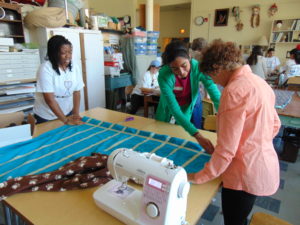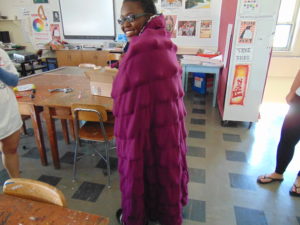Ball Blankets
 Have you ever wondered what it’s like to be autistic? Based on first-hand accounts of people with autism, it is a world in which all stimuli have the same volume as all others. It is a cacophony of sound and stimuli. This audio of a person with autism gives non-autistic people a good sense of what it is like to be living with autism.
Have you ever wondered what it’s like to be autistic? Based on first-hand accounts of people with autism, it is a world in which all stimuli have the same volume as all others. It is a cacophony of sound and stimuli. This audio of a person with autism gives non-autistic people a good sense of what it is like to be living with autism.
Given the collision of sound and stimuli experienced by autistic people, you can imagine how helpful a calming device would be to them.
Ball blankets are weighted blankets which reportedly provide sensory stimulation and provide a calming effect. In one study, researchers found that the time it takes for a child with ADHD to fall asleep is shortened when using a ball blanket to the same time as healthy control subjects. In addition, teachers found improvement in both activity levels and attention span of approximately 10% after using the ball blankets.
In an article on Inc.com, Melanie Curtin wrote about the scientific basis for weighted blankets. Melanie’s interesting article including the following evidence for the benefits of weighted blankets in reducing anxiety and assisting in sleep:
“One study found that 63% of participants reported weighted blankets as helping significantly reduce their levels of anxiety. Another demonstrated that those who used weighted blankets cited less anxiety than those who didn’t, and that clinicians agreed with their assessments.
 Research also shows that weighted blankets help “ground” the body during sleep. This effect, also known as “earthing”, helps regulate your circadian rhythm, as well. One study showed that grounding not only helps reduce cortisol production (again, reducing stress), but also enhances the body’s natural, 24-hour circadian rhythms–especially in women. This led to higher-quality sleep in research participants, as well as reduced stress and pain.
Research also shows that weighted blankets help “ground” the body during sleep. This effect, also known as “earthing”, helps regulate your circadian rhythm, as well. One study showed that grounding not only helps reduce cortisol production (again, reducing stress), but also enhances the body’s natural, 24-hour circadian rhythms–especially in women. This led to higher-quality sleep in research participants, as well as reduced stress and pain.
Finally, because weighted blankets help make up for low levels of serotonin in the brain, they can be used to fight more than just anxiety–they can help with ADHD, depression, OCD, PTSD, bipolar disorder, Tourette’s, Alzheimer’s, cerebral palsy, Restless Leg Syndrome, and more (even menopausal symptoms).”
Weighted blankets typically cost hundreds of dollars. Our blankets are given to individuals and organizations servicing people who can benefit from weighted blankets.
Our prototype blanket contained 99 balls and is suitable for a child weighing around 50 pounds.
Since 2014 we have collected over 12,000 balls to sew into 50 ball blankets!
Recipients of the blankets include – The Doug Flutie, Jr. Foundation for Autism, Cooperative for Human Services, TILL- Toward Independent Living and Learning, Autism Alliance of Metrowest, The Walker School, Cardinal Cushing School, The Shared Living Collaborative, the Lurie Center for Autism at the Massachusetts General Hospital for Children, The Gifford School, The Higginson Lewis K-8 School, the John Silber Early Learning Center and individuals.
“We just gave one of the blankets to a family yesterday and they were so happy!! They are clean, soft and perfect weight for so many of the children with autism we see here at the Autism Alliance. We can’t thank SquashCares enough for their generosity and community outreach.”
— Allison Daigle, Executive Co-Director, Autism Alliance of MetroWest
“The SquashCares sensory blankets can offer a sense of security and produce a calming effect for individuals with autism who have specific sensory needs. Thank you to SquashCares for their continued support of the autism community and for ‘helping families affected by autism live life to the fullest!’”
— Lisa Collins, Director of Community Partnerships & Family Supports, Doug Flutie, Jr. Foundation for Autism
Want to make your own ball blanket? Here are the steps you need to follow:
First, decide which size blanket you want to make. We make three different sizes of blankets – a blanket containing 100 squash balls suitable for a person weighing 50 pounds or less (final blanket weight around 5 lbs); a blanket containing 204 squash balls suitable for a person weighing between 100 and 50 pounds (final blanket weight around 10 lbs); and a blanket containing 300 squash balls suitable for a person weighing between 100 and 150 pounds (final blanket weight around 15 lbs).
Then you need the right size fleece and number of squash balls for the size of blanket you have chosen to make:
- 5 lbs blanket – two 48″x 58″ fleece sheets and 100 squash balls
- 10 lbs blanket – two 48″x 76″ fleece sheets and 204 squash balls
- 15 lbs blanket – two 48″x 87″ fleece sheets and 300 squash balls
Once you have the fleece and balls, you will need the following:
- thread for sewing
- sewing machine
- scissors
- yardstick/tape measure
- painter’s tape/pins to mark channels
Now that you have all the materials, you can prepare the blanket.
Use safety pins to pin together the edges of two sheets of fleece.
Sew together three sides of the blanket, make sure the fourth is left open. Go about an inch deep on each side.
Trim the excess inch of fleece on the three sides of the blanket you have sewn together, flip it inside out, and poke at the corners.
Next you need to measure out vertical channels of equal width. The channels extend the entire length of the blanket and are marked using
painter’s tape or pins. Depending on the size of your blanket, you will have the following number of channels:
- 5 lbs blanket (100 balls)- 10 channels (10 spots for balls, 9 pieces of tape or rows of pins)
- 10 lbs blanket (204 balls)- 12 channels (12 spots for balls, 11 pieces of tape or rows of pins)
- 15 lbs blanket (300 balls)- 15 channels (15 spots for balls, 14 pieces of tape or rows of pins)
After the channels are marked, sew the channels along the taped lines or pins. Then remove the tape or pins.
Now measure out horizontal channels of equal width. The rows extend the entire length of the blanket and are marked using the painter’s tape or pins. Depending on the size of your blanket, you will have the following number of channels:
- 5 lbs blanket (100 balls)- 10 channels (10 spots for balls, 9 pieces of tape or rows of pins)
- 10 lbs blanket (204 balls)- 17 channels (17 spots for balls, 16 pieces of tape or rows of pins)
- 15 lbs blanket (300 balls) – 20 channels (20 spots for balls, 19 pieces of tape or rows of pins)
Now you may roll one squash ball down each vertical channel until there is a ball in each channel of the lowest row. Then sew the row off along the line made by the masking tape along the horizontal row. Repeat for each row until all rows are sewed off. Then remove all the masking tape.
When you get to the top of the blanket, fold the raw edges inward and machine stitch it closed. Start and finish with a back stitch for a stronger stitch.
It is best to have around 4 people working on each blanket as it takes a number of people to manipulate the blanket and to roll the balls while holding the blanket. Also as the weight and size of the blanket increases, the difficulty of the work increases.
Here is a step-by-step tutorial of a sample 4×4 blanket.
The same process applies to any size blanket – sew the two pieces of fleece together, prepare and sew vertical channels, mark horizontal rows, roll balls, sew off rows, and sew off the top.
